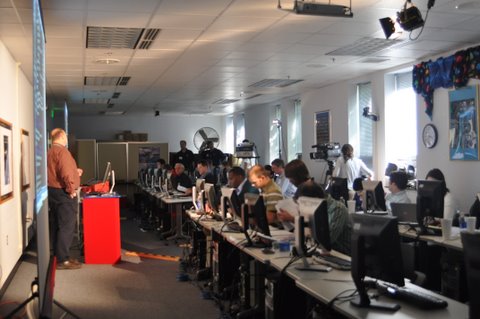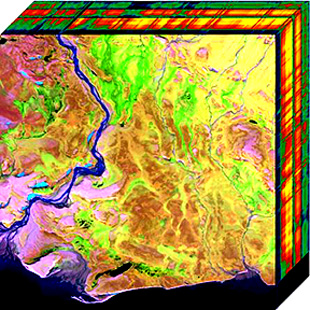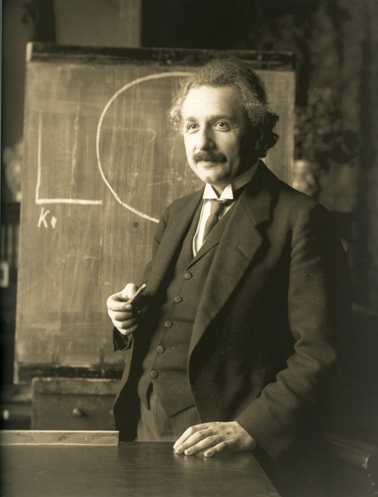Antennas: The Interface with Space by Robert A. Nelson The antenna is the most visible part of the satellite communication system. The antenna transmits and receives the modulated carrier signal at the radio frequency (RF) portion of the electromagnetic spectrum. For satellite communication, the frequencies range from about 0.3 GHz (VHF) to 30 GHz (Ka-band) […]
Antennas: The Interface with Space
by Robert A. Nelson
The antenna is the most visible part of the satellite communication system. The antenna transmits and receives the modulated carrier signal at the radio frequency (RF) portion of the electromagnetic spectrum. For satellite communication, the frequencies range from about 0.3 GHz (VHF) to 30 GHz (Ka-band) and beyond. These frequencies represent microwaves, with wavelengths on the order of one meter down to below one centimeter. High frequencies, and the corresponding small wavelengths, permit the use of antennas having practical dimensions for commercial use. This article summarizes the basic properties of antennas used in satellite communication and derives several fundamental relations used in antenna design and RF link analysis.
HISTORY OF ELECTROMAGNETIC WAVES
The quantitative study of electricity and magnetism began with the scientific research of the French physicist Charles Augustin Coulomb. In 1787 Coulomb proposed a law of force for charges that, like Sir Isaac Newton’s law of gravitation, varied inversely as the square of the distance. Using a sensitive torsion balance, he demonstrated its validity experimentally for forces of both repulsion and attraction. Like the law of gravitation, Coulomb’s law was based on the notion of “action at a distance,” wherein bodies can interact instantaneously and directly with one another without the intervention of any intermediary.
At the beginning of the nineteenth century, the electrochemical cell was invented by Alessandro Volta, professor of natural philosophy at the University of Pavia in Italy. The cell created an electromotive force, which made the production of continuous currents possible. Then in 1820 at the University of Copenhagen, Hans Christian Oersted made the momentous discovery that an electric current in a wire could deflect a magnetic needle. News of this discovery was communicated to the French Academy of Sciences two months later. The laws of force between current bearing wires were at once investigated by Andre-Marie Ampere and by Jean-Baptiste Biot and Felix Savart. Within six years the theory of steady currents was complete. These laws were also “action at a distance” laws, that is, expressed directly in terms of the distances between the current elements.
Subsequently, in 1831, the British scientist Michael Faraday demonstrated the reciprocal effect, in which a moving magnet in the vicinity of a coil of wire produced an electric current. This phenomenon, together with Oersted’s experiment with the magnetic needle, led Faraday to conceive the notion of a magnetic field. A field produced by a current in a wire interacted with a magnet. Also, according to his law of induction, a time varying magnetic field incident on a wire would induce a voltage, thereby creating a current. Electric forces could similarly be expressed in terms of an electric field created by the presence of a charge.
Faraday’s field concept implied that charges and currents interacted directly and locally with the electromagnetic field, which although produced by charges and currents, had an identity of its own. This view was in contrast to the concept of “action at a distance,” which assumed bodies interacted directly with one another. Faraday, however, was a self-taught experimentalist and did not formulate his laws mathematically.
It was left to the Scottish physicist James Clerk Maxwell to establish the mathematical theory of electromagnetism based on the physical concepts of Faraday. In a series of papers published between 1856 and 1865, Maxwell restated the laws of Coulomb, Ampere, and Faraday in terms of Faraday’s electric and magnetic fields. Maxwell thus unified the theories of electricity and magnetism, in the same sense that two hundred years earlier Newton had unified terrestrial and celestial mechanics through his theory of universal gravitation.
As is typical of abstract mathematical reasoning, Maxwell saw in his equations a certain symmetry that suggested the need for an additional term, involving the time rate of change of the electric field. With this generalization, Maxwell’s equations also became consistent with the principle of conservation of charge.
Furthermore, Maxwell made the profound observation that his set of equations, thus modified, predicted the existence of electromagnetic waves. Therefore, disturbances in the electromagnetic field could propagate through space. Using the values of known experimental constants obtained solely from measurements of charges and currents, Maxwell deduced that the speed of propagation was equal to speed of light. This quantity had been measured astronomically by Olaf Romer in 1676 from the eclipses of Jupiter’s satellites and determined experimentally from terrestrial measurements by H.L. Fizeau in 1849. He then asserted that light itself was an electromagnetic wave, thereby unifying optics with electromagnetism as well.
Maxwell was aided by his superior knowledge of dimensional analysis and units of measure. He was a member of the British Association committee formed in 1861 that eventually established the centimeter-gram-second (CGS) system of absolute electrical units.
Maxwell’s theory was not accepted by scientists immediately, in part because it had been derived from a bewildering collection of mechanical analogies and difficult mathematical concepts. The form of Maxwell’s equations as they are known today is due to the German physicist Heinrich Hertz. Hertz simplified them and eliminated unnecessary assumptions.
Hertz’s interest in Maxwell’s theory was occasioned by a prize offered by the Berlin Academy of Sciences in 1879 for research on the relation between polarization in insulators and electromagnetic induction. By means of his experiments, Hertz discovered how to generate high frequency electrical oscillations. He was surprised to find that these oscillations could be detected at large distances from the apparatus. Up to that time, it had been generally assumed that electrical forces decreased rapidly with distance according to the Newtonian law. He therefore sought to test Maxwell’s prediction of the existence of electromagnetic waves.
In 1888, Hertz set up standing electromagnetic waves using an oscillator and spark detector of his own design and made independent measurements of their wavelength and frequency. He found that their product was indeed the speed of light. He also verified that these waves behaved according to all the laws of reflection, refraction, and polarization that applied to visible light, thus demonstrating that they differed from light only in wavelength and frequency. “Certainly it is a fascinating idea,” Hertz wrote, “that the processes in air that we have been investigating represent to us on a million-fold larger scale the same processes which go on in the neighborhood of a Fresnel mirror or between the glass plates used in exhibiting Newton’s rings.”
It was not long until the discovery of electromagnetic waves was transformed from pure physics to engineering. After learning of Hertz’s experiments through a magazine article, the young Italian engineer Guglielmo Marconi constructed the first transmitter for wireless telegraphy in 1895. Within two years he used this new invention to communicate with ships at sea. Marconi’s transmission system was improved by Karl F. Braun, who increased the power, and hence the range, by coupling the transmitter to the antenna through a transformer instead of having the antenna in the power circuit directly. Transmission over long distances was made possible by the reflection of radio waves by the ionosphere. For their contributions to wireless telegraphy, Marconi and Braun were awarded the Nobel Prize in physics in 1909.
Marconi created the American Marconi Wireless Telegraphy Company in 1899, which competed directly with the transatlantic undersea cable operators. On the early morning of April 15, 1912, a 21-year old Marconi telegrapher in New York City by the name of David Sarnoff received a wireless message from the Marconi station in Newfoundland, which had picked up faint SOS distress signals from the steamship Titanic. Sarnoff relayed the report of the ship’s sinking to the world. This singular event dramatized the importance of the new means of communication.
Initially, wireless communication was synonymous with telegraphy. For communication over long distances the wavelengths were greater than 200 meters. The antennas were typically dipoles formed by long wires cut to a submultiple of the wavelength.
Commercial radio emerged during the 1920s and 1930s. The American Marconi Company evolved into the Radio Corporation of America (RCA) with David Sarnoff as its director. Technical developments included the invention of the triode for amplification by Lee de Forest and the perfection of AM and FM receivers through the work of Edwin Howard Armstrong and others. In his book Empire of the Air: The Men Who Made Radio, Tom Lewis credits de Forest, Armstrong, and Sarnoff as the three visionary pioneers most responsible for the birth of the modern communications age.
Stimulated by the invention of radar during World War II, considerable research and development in radio communication at microwave frequencies and centimeter wavelengths was conducted in the decade of the 1940s. The MIT Radiation Laboratory was a leading center for research on microwave antenna theory and design. The basic formulation of the radio transmission formula was developed by Harald T. Friis at the Bell Telephone Laboratories and published in 1946. This equation expressed the radiation from an antenna in terms of the power flow per unit area, instead of giving the field strength in volts per meter, and is the foundation of the RF link equation used by satellite communication engineers today.
TYPES OF ANTENNAS
A variety of antenna types are used in satellite communications. The most widely used narrow beam antennas are reflector antennas. The shape is generally a paraboloid of revolution. For full earth coverage from a geostationary satellite, a horn antenna is used. Horns are also used as feeds for reflector antennas.
In a direct feed reflector, such as on a satellite or a small earth terminal, the feed horn is located at the focus or may be offset to one side of the focus. Large earth station antennas have a subreflector at the focus. In the Cassegrain design, the subreflector is convex with an hyperboloidal surface, while in the Gregorian design it is concave with an ellipsoidal surface.
The subreflector permits the antenna optics to be located near the base of the antenna. This configuration reduces losses because the length of the waveguide between the transmitter or receiver and the antenna feed is reduced. The system noise temperature is also reduced because the receiver looks at the cold sky instead of the warm earth. In addition, the mechanical stability is improved, resulting in higher pointing accuracy.
Phased array antennas may be used to produce multiple beams or for electronic steering. Phased arrays are found on many nongeostationary satellites, such as the Iridium, Globalstar, and ICO satellites for mobile telephony.
GAIN AND HALF POWER BEAMWIDTH
The fundamental characteristics of an antenna are its gain and half power beamwidth. According to the reciprocity theorem, the transmitting and receiving patterns of an antenna are identical at a given wavelength
The gain is a measure of how much of the input power is concentrated in a particular direction. It is expressed with respect to a hypothetical isotropic antenna, which radiates equally in all directions. Thus in the direction (q , f ), the gain is
G(q , f ) = (dP/dW)/(Pin /4p )
where
Pin is the total input power and dP is the increment of radiated output power in solid angle dW. The gain is maximum along the boresight direction.
The input power is Pin = Ea2 A / h Z0 where Ea is the average electric field over the area A of the aperture, Z0 is the impedance of free space, and h is the net antenna efficiency. The output power over solid angle dWis dP = E2 r2 dW/ Z0, where E is the electric field at distance r. But by the Fraunhofer theory of diffraction, E = Ea A / r l along the boresight direction, where l is the wavelength. Thus the boresight gain is given in terms of the size of the antenna by the important relation
G = h (4 p / l2) A
This equation determines the required antenna area for the specified gain at a given wavelength.
The net efficiency h is the product of the aperture taper efficiency ha , which depends on the electric field distribution over the antenna aperture (it is the square of the average divided by the average of the square), and the total radiation efficiency h * = P/Pin associated with various losses. These losses include spillover, ohmic heating, phase non-uniformity, blockage, surface roughness, and cross polarization. Thus h = ha h *. For a typical antenna, h = 0.55.
For a reflector antenna, the area is simply the projected area. Thus for a circular reflector of diameter D, the area is A = p D2/4 and the gain is
G = h (p D / l )2
which can also be written
G = h (p D f / c)2
since c = l f, where c is the speed of light (3 ´ 108 m/s), l is the wavelength, and f is the frequency. Consequently, the gain increases as the wavelength decreases or the frequency increases.
For example, an antenna with a diameter of 2 m and an efficiency of 0.55 would have a gain of 8685 at the C-band uplink frequency of 6 GHz and wavelength of 0.050 m. The gain expressed in decibels (dB) is
10 log(8685) = 39.4 dB.
Thus the power radiated by the antenna is 8685 times more concentrated along the boresight direction than for an isotropic antenna, which by definition has a gain of 1 (0 dB). At Ku-band, with an uplink frequency of 14 GHz and wavelength 0.021 m, the gain is 49,236 or 46.9 dB. Thus at the higher frequency, the gain is higher for the same size antenna.
The boresight gain G can be expressed in terms of the antenna beam solid angle WA that contains the total radiated power as
G = h * (4p / WA )
which takes into account the antenna losses through the radiation efficiency h *. The antenna beam solid angle is the solid angle through which all the power would be concentrated if the gain were constant and equal to its maximum value. The directivity does not include radiation losses and is equal to G / h *.
The half power beamwidth is the angular separation between the half power points on the antenna radiation pattern, where the gain is one half the maximum value. For a reflector antenna it may be expressed
HPBW = a = k l / D
where k is a factor that depends on the shape of the reflector and the method of illumination. For a typical antenna, k = 70° (1.22 if a is in radians). Thus the half power beamwidth decreases with decreasing wavelength and increasing diameter.
For example, in the case of the 2 meter antenna, the half power beamwidth at 6 GHz is approximately 1.75° . At 14 GHz, the half power beamwidth is approximately 0.75° . As an extreme example, the half power beamwidth of the Deep Space Network 64 meter antenna in Goldstone, California is only 0.04 ° at X-band (8.4 GHz).
The gain may be expressed directly in terms of the half power beamwidth by eliminating the factor D/l . Thus,
G = h (p k / a )2
Inserting the typical values h = 0.55 and k = 70° , one obtains
G = 27,000/ (a° )2
where a° is expressed in degrees. This is a well known engineering approximation for the gain (expressed as a numeric). It shows directly how the size of the beam automatically determines the gain. Although this relation was derived specifically for a reflector antenna with a circular beam, similar relations can be obtained for other antenna types and beam shapes. The value of the numerator will be somewhat different in each case.
For example, for a satellite antenna with a circular spot beam of diameter 1° , the gain is 27,000 or 44.3 dB. For a Ku-band downlink at 12 GHz, the required antenna diameter determined from either the gain or the half power beamwidth is 1.75 m.
A horn antenna would be used to provide full earth coverage from geostationary orbit, where the angular diameter of the earth is 17.4° . Thus, the required gain is 89.2 or 19.5 dB. Assuming an efficiency of 0.70, the horn diameter for a C-band downlink frequency of 4 GHz would be 27 cm.
EIRP AND G/T
For the RF link budget, the two required antenna properties are the equivalent isotropic radiated power (EIRP) and the “figure of merit” G/T. These quantities are the properties of the transmit antenna and receive antenna that appear in the RF link equation and are calculated at the transmit and receive frequencies, respectively.
The equivalent isotropic radiated power (EIRP) is the power radiated equally in all directions that would produce a power flux density equivalent to the power flux density of the actual antenna. The power flux density F is defined as the radiated power P per unit area S, or F = P/S. But P = h * Pin , where Pin is the input power and h * is the radiation efficiency, and S = d2 WA ,where d is the slant range to the center of coverage and WA is the solid angle containing the total power. Thus with some algebraic manipulation,
F = h * (4p / WA )( Pin / 4p d2) = G Pin / 4p d2
Since the surface area of a sphere of radius d is 4p d2, the flux density in terms of the EIRP is
F = EIRP / 4p d2
Equating these two expressions, one obtains
EIRP = G Pin
Therefore, the equivalent isotropic radiated power is the product of the antenna gain of the transmitter and the power applied to the input terminals of the antenna. The antenna efficiency is absorbed in the definition of gain.
The “figure of merit” is the ratio of the antenna gain of the receiver G and the system temperature T. The system temperature is a measure of the total noise power and includes contributions from the antenna and the receiver. Both the gain and the system temperature must be referenced to the same point in the chain of components in the receiver system. The ratio G/T is important because it is an invariant that is independent of the reference point where it is calculated, even though the gain and the system temperature individually are different at different points.
ANTENNA PATTERN
Since electromagnetic energy propagates in the form of waves, it spreads out through space due to the phenomenon of diffraction. Individual waves combine both constructively and destructively to form a diffraction pattern that manifests itself in the main lobe and side lobes of the antenna.
The antenna pattern is analogous to the “Airy rings” produced by visible light when passing through a circular aperture. These diffraction patterns were studied by Sir George Biddell Airy, Astronomer Royal of England during the nineteenth century, to investigate the resolving power of a telescope. The diffraction pattern consists of a central bright spot surrounded by concentric bright rings with decreasing intensity.
The central spot is produced by waves that combine constructively and is analogous to the main lobe of the antenna. The spot is bordered by a dark ring, where waves combine destructively, that is analogous to the first null. The surrounding bright rings are analogous to the side lobes of the antenna pattern. As noted by Hertz, the only difference in this behavior is the size of the pattern and the difference in wavelength.
Within the main lobe of an axisymmetric antenna, the gain G(q ) in a direction q with respect to the boresight direction may be approximated by the expression
G(q ) = G – 12 (q / a )2
where G is the boresight gain. Here the gains are expressed in dB. Thus at the half power points to either side of the boresight direction, where q = a /2, the gain is reduced by a factor of 2, or 3 dB. The details of the antenna, including its shape and illumination, are contained in the value of the half power beamwidth a . This equation would typically be used to estimate the antenna loss due to a small pointing error.
The gain of the side lobes can be approximated by an envelope. For new earth station antennas with D/l > 100, the side lobes must fall within the envelope 29 – 25 log q by international regulation. This envelope is determined by the requirement of minimizing interference between neighboring satellites in the geostationary arc with a nominal 2° spacing.
TAPER
The gain pattern of a reflector antenna depends on how the antenna is illuminated by the feed. The variation in electric field across the antenna diameter is called the antenna taper.
The total antenna solid angle containing all of the radiated power, including side lobes, is
WA = h * (4p / G) = (1/ha) (l2 / A)
where ha is the aperture taper efficiency and h * is the radiation efficiency associated with losses. The beam efficiency is defined as
e = WM / WA
where WM is thesolid angle for the main lobe. The values of ha and are e calculated from the electric field distribution in the aperture plane and the antenna radiation pattern, respectively.
For a theoretically uniform illumination, the electric field is constant and the aperture taper efficiency is 1. If the feed is designed to cause the electric field to decrease with distance from the center, then the aperture taper efficiency decreases but the proportion of power in the main lobe increases. In general, maximum aperture taper efficiency occurs for a uniform distribution, but maximum beam efficiency occurs for a highly tapered distribution.
For uniform illumination, the half power beamwidth is 58.4° l /D and the first side lobe is 17.6 dB below the peak intensity in the boresight direction. In this case, the main lobe contains about 84 percent of the total radiated power and the first side lobe contains about 7 percent.
If the electric field amplitude has a simple parabolic distribution, falling to zero at the reflector edge, then the aperture taper efficiency becomes 0.75 but the fraction of power in the main lobe increases to 98 percent. The half power beamwidth is now 72.8° l /D and the first side lobe is 24.6 dB below peak intensity. Thus, although the aperture taper efficiency is less, more power is contained in the main lobe, as indicated by the larger half power beamwidth and lower side lobe intensity.
If the electric field decreases to a fraction C of its maximum value, called the edge taper, the reflector will not intercept all the radiation from the feed. There will be energy spillover with a corresponding efficiency of approximately 1 – C2. However, as the spillover efficiency decreases, the aperture taper efficiency increases. The taper is chosen to maximize the illumination efficiency, defined as the product of aperture taper efficiency and spillover efficiency.
The illumination efficiency reaches a maximum value for an optimum combination of taper and spillover. For a typical antenna, the optimum edge taper C is about 0.316, or – 10 dB (20 log C). With this edge taper and a parabolic illumination, the aperture taper efficiency is 0.92, the spillover efficiency is 0.90, the half power beamwidth is 65.3° l /D, and the first side lobe is 22.3 dB below peak. Thus the overall illumination efficiency is 0.83 instead of 0.75. The beam efficiency is about 95 percent.
COVERAGE AREA
The gain of a satellite antenna is designed to provide a specified area of coverage on the earth. The area of coverage within the half power beamwidth is
S = d2 W
where d is the slant range to the center of the footprint and W is the solid angle of a cone that intercepts the half power points, which may be expressed in terms of the angular dimensions of the antenna beam. Thus
= K a b
where a and b are the principal plane half power beamwidths in radians and K is a factor that depends on the shape of the coverage area. For a square or rectangular area of coverage, K = 1, while for a circular or elliptical area of coverage, K = p /4.
The boresight gain may be approximated in terms of this solid angle by the relation
G = h¢ (4p / W ) = (h¢ / K)(41,253 / a° b° )
where a° and b° are in degrees and h¢ is an efficiency factor that depends on the the half power beamwidth. Although h¢ is conceptually distinct from the net efficiency h , in practice these two efficiencies are roughly equal for a typical antenna taper. In particular, for a circular beam this equation is equivalent to the earlier expression in terms of a if h¢ = (p k / 4)2 h .
If the area of the footprint S is specified, then the size of a satellite antenna increases in proportion to the altitude. For example, the altitude of Low Earth Orbit is about 1000 km and the altitude of Medium Earth Orbit is about 10,000 km. Thus to cover the same area on the earth, the antenna diameter of a MEO satellite must be about 10 times that of a LEO satellite and the gain must be 100 times, or 20 dB, as great.
On the Iridium satellite there are three main mission L-band phased array antennas. Each antenna has 106 elements, distributed into 8 rows with element separations of 11.5 cm and row separations of 9.4 cm over an antenna area of 188 cm ´ 86 cm. The pattern produced by each antenna is divided into 16 cells by a two-dimensional Butler matrix power divider, resulting in a total of 48 cells over the satellite coverage area. The maximum gain for a cell at the perimeter of the coverage area is 24.3 dB.
From geostationary orbit the antenna size for a small spot beam can be considerable. For example, the spacecraft for the Asia Cellular Satellite System (ACeS), being built by Lockheed Martin for mobile telephony in Southeast Asia, has two unfurlable mesh antenna reflectors at L-band that are 12 meters across and have an offset feed. Having different transmit and receive antennas minimizes passive intermodulation (PIM) interference that in the past has been a serious problem for high power L-band satellites using a single reflector. The antenna separation attenuates the PIM products by from 50 to 70 dB.
SHAPED BEAMS
Often the area of coverage has an irregular shape, such as one defined by a country or continent. Until recently, the usual practice has been to create the desired coverage pattern by means of a beam forming network. Each beam has its own feed and illuminates the full reflector area. The superposition of all the individual circular beams produces the specified shaped beam.
For example, the C-band transmit hemi/zone antenna on the Intelsat 6 satellite is 3.2 meters in diameter. This is the largest diameter solid circular aperture that fits within an Ariane 4 launch vehicle fairing envelope. The antenna is illuminated by an array of 146 Potter horns. The beam diameter a for each feed is 1.6° at 3.7 GHz. By appropriately exciting the beam forming network, the specified areas of coverage are illuminated. For 27 dB spatial isolation between zones reusing the same spectrum, the minimum spacing s is given by the rule of thumb s ³ 1.4 a , so that s ³ 2.2° . This meets the specification of s = 2.5° for Intelsat 6.
Another example is provided by the HS-376 dual-spin stabilized Galaxy 5 satellite, operated by PanAmSat. The reflector diameter is 1.80 m. There are two linear polarizations, horizontal and vertical. In a given polarization, the contiguous United States (CONUS) might be covered by four beams, each with a half power beamwidth of 3° at the C-band downlink frequency of 4 GHz. From geostationary orbit, the angular dimensions of CONUS are approximately 6° ´ 3° . For this rectangular beam pattern, the maximum gain is about 31 dB. At edge of coverage, the gain is 3 dB less. With a TWTA ouput power of 16 W (12 dBW), a waveguide loss of 1.5 dB, and an assumed beam-forming network loss of 1 dB, the maximum EIRP is 40.5 dBW.
The shaped reflector represents a new technology. Instead of illuminating a conventional parabolic reflector with multiple feeds in a beam-forming network, there is a single feed that illuminates a reflector with an undulating shape that provides the required region of coverage. The advantages are lower spillover loss, a significant reduction in mass, lower signal losses, and lower cost. By using large antenna diameters, the rolloff along the perimeter of the coverage area can be made sharp. The practical application of shaped reflector technology has been made possible by the development of composite materials with extremely low coefficients of thermal distortion and by the availability of sophisticated computer software programs necessary to analyze the antenna. One widely used antenna software package is called GRASP, produced by TICRA of Copenhagen, Denmark. This program calculates the gain from first principles using the theory of physical optics.
SUMMARY
The gain of an antenna is determined by the intended area of coverage. The gain at a given wavelength is achieved by appropriately choosing the size of the antenna. The gain may also be expressed in terms of the half power beamwidth.
Reflector antennas are generally used to produce narrow beams for geostationary satellites and earth stations. The efficiency of the antenna is optimized by the method of illumination and choice of edge taper. Phased array antennas are used on many LEO and MEO satellites. New technologies include large, unfurlable antennas for producing small spot beams from geostationary orbit and shaped reflectors for creating a shaped beam with only a single feed.
Dr. Robert A. Nelson, P.E. is president of Satellite Engineering Research Corporation, a satellite engineering consulting firm in Bethesda, Maryland, a Lecturer in the Department of Aerospace Engineering at the University of Maryland and Technical Editor of Via Satellite magazine.

 How to Promote Your ATI Course in Social Media
LinkedIn for ATI Rocket Scientists
Did you know that for 52% of professionals and executives, their LinkedIn profile is the #1 or #2 search result when someone searches on their name?
For ATI instructors, that number is substantially lower – just 17%. One reason is that about 25% of ATI instructors do not have a LinkedIn profile. Others have done so little with their profile that it isn’t included in the first page of search results.
If you are not using your LinkedIn profile, you are missing a huge opportunity. When people google you, your LinkedIn profile is likely the first place they go to learn about you. You have little control over what other information might be available on the web about you. But you have complete control over your LinkedIn profile. You can use your profile to tell your story – to give people the exact information you want them to have about your expertise and accomplishments.
Why not take advantage of that to promote your company, your services, and your course?
How to Promote Your ATI Course in Social Media
LinkedIn for ATI Rocket Scientists
Did you know that for 52% of professionals and executives, their LinkedIn profile is the #1 or #2 search result when someone searches on their name?
For ATI instructors, that number is substantially lower – just 17%. One reason is that about 25% of ATI instructors do not have a LinkedIn profile. Others have done so little with their profile that it isn’t included in the first page of search results.
If you are not using your LinkedIn profile, you are missing a huge opportunity. When people google you, your LinkedIn profile is likely the first place they go to learn about you. You have little control over what other information might be available on the web about you. But you have complete control over your LinkedIn profile. You can use your profile to tell your story – to give people the exact information you want them to have about your expertise and accomplishments.
Why not take advantage of that to promote your company, your services, and your course?
 Here are some simple ways to promote your course using LinkedIn…
On Your LinkedIn Profile
Let’s start by talking about how to include your course on your LinkedIn profile so it is visible anytime someone googles you or visits your profile.
1. Add your role as an instructor.
Let people know that this course is one of the ways you share your knowledge. You can include your role as an instructor in several places on your profile:
Here are some simple ways to promote your course using LinkedIn…
On Your LinkedIn Profile
Let’s start by talking about how to include your course on your LinkedIn profile so it is visible anytime someone googles you or visits your profile.
1. Add your role as an instructor.
Let people know that this course is one of the ways you share your knowledge. You can include your role as an instructor in several places on your profile:
 3. Upload course materials.
You can upload course materials to help people better understand the content you cover. You could include PowerPoint presentations (from this course or other training), course handouts (PDFs), videos or graphics. They can be added to your Summary, Experience or Project. You can see an example of an upload above, in Tom Logsdon’s profile.
4. Add skills related to your course.
LinkedIn allows you to include up to 50 skills on your profile. If your current list of skills doesn’t include the topics you cover in your course, you might want to add them.
Go to the Skills & Endorsements section on your Edit Profile page, then click on Add skill. Start typing and let LinkedIn auto-complete your topic. If your exact topic isn’t included in the suggestions, you can add it.
5. Ask students for recommendations.
Are you still in touch with former students who were particularly appreciative of the training you provided in your course? You might want to ask them for a recommendation that you can include on your profile. Here are some tips on
3. Upload course materials.
You can upload course materials to help people better understand the content you cover. You could include PowerPoint presentations (from this course or other training), course handouts (PDFs), videos or graphics. They can be added to your Summary, Experience or Project. You can see an example of an upload above, in Tom Logsdon’s profile.
4. Add skills related to your course.
LinkedIn allows you to include up to 50 skills on your profile. If your current list of skills doesn’t include the topics you cover in your course, you might want to add them.
Go to the Skills & Endorsements section on your Edit Profile page, then click on Add skill. Start typing and let LinkedIn auto-complete your topic. If your exact topic isn’t included in the suggestions, you can add it.
5. Ask students for recommendations.
Are you still in touch with former students who were particularly appreciative of the training you provided in your course? You might want to ask them for a recommendation that you can include on your profile. Here are some tips on 



